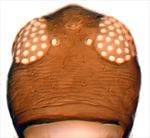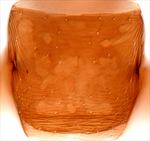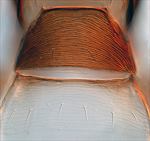
Ant-like female with short wings

Antenna (bright field)

Head

Pronotum

Mesonotum & metanotum (wingless female)

Pterothorax and abdominal tergites I-II

Tergites I–II
Usually micropterous, with wings shorter than thorax width; fully winged females rare, with wings relatively short and slender. Body color brown with abdominal segments II–III sharply yellow, mesothorax and abdominal segment X sometimes yellowish, antennal segments II and most of III yellow; legs brown; fore wing with two transverse dark bands, costa dark on pale area between the dark bands. Antennae 9-segmented, segments III–IV with linear sensorium short and straight, V–IX forming a single unit with V longer than VI–IX. Head and pronotum with no long setae; eyes strongly prolonged on ventral surface; maxillary palps 3-segmented. Fore tarsus apically with stout recurved ventral hamus. Abdominal tergite I with many closely spaced transverse striae; sternal marginal setae arising sub-marginally, particularly the two lateral pairs.
Male micropterous; generally brown, or with mesothorax and abdominal segments I, II and part of IV yellow, abdominal segments IX and X darkest; IX without paired claspers.
In addition to A. albicinctus, two further species recorded from California have the basal abdominal segments sharply yellow, A. auricestus and A. brunneipictus. Moreover, at least two other Aeolothrips species occur in western USA with the abdomen bicolored, A. aureus Moulton and A. bicolor Hinds. These five species apparently all live at ground level as predators of small arthropods. About 105 species are placed currently in the genus Aeolothrips (Alavi & Minaei, 2018). Most of these are from the Palaearctic Region (including the Mediterranean, Iran and northern India, but with five species extending through eastern Africa to South Africa), with about 30 species from the Nearctic (mainly western USA). Only one species of this genus is known from the Neotropics, A. fasciatipennis described from Chile, but Mound & Marullo (1996) indicate this is probably the same as A. fasciatus.
Living at the base of grasses, and presumably predatory on mites; behavior distinctively active and wasp-like.
Widespread across Europe into Asia, also North America (Ontario, New York, New Jersey, Massachusetts, Illinois, Iowa, California).
AEOLOTHRIPIDAE
Aeolothrips albicinctus Haliday
Aeolothrips albicinctus Haliday, 1836: 451
Aeolothrips flavithorax Priesner, 1926: 102
Alavi J & Minaei K. (2018) Studies on the genus Aeolothrips (Thysanoptera: Aeolothripidae) in Iran, with a key to species. Zootaxa 4446 (3): 343–360.
Mound LA & Marullo R (1996) The Thrips of Central and South America: An Introduction. Memoirs on Entomology, International 6: 1–488.
zur Strassen R (2003) Die terebranten Thysanopteren Europas und des Mittelmeer-Gebietes. Die Tierwelt Deutschlands 74: 1–271.